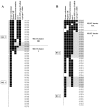Virulence Profiles of Vibrio vulnificus in German Coastal Waters, a Comparison of North Sea and Baltic Sea Isolates
- PMID: 26694432
- PMCID: PMC4690967
- DOI: 10.3390/ijerph121215031
Virulence Profiles of Vibrio vulnificus in German Coastal Waters, a Comparison of North Sea and Baltic Sea Isolates
Abstract
Vibrio vulnificus is a halophilic bacterium of coastal environments known for sporadically causing severe foodborne or wound infections. Global warming is expected to lead to a rising occurrence of V. vulnificus and an increasing incidence of human infections in Northern Europe. So far, infections in Germany were exclusively documented for the Baltic Sea coast, while no cases from the North Sea region have been reported. Regional variations in the prevalence of infections may be influenced by differences in the pathogenicity of V. vulnificus populations in both areas. This study aimed to compare the distribution of virulence-associated traits and genotypes among 101 V. vulnificus isolates from the Baltic Sea and North Sea in order to assess their pathogenicity potential. Furthermore, genetic relationships were examined by multilocus sequence typing (MLST). A high diversity of MLST sequences (74 sequence types) and differences regarding the presence of six potential pathogenicity markers were observed in the V. vulnificus populations of both areas. Strains with genotypes and markers associated with pathogenicity are not restricted to a particular geographic region. This indicates that lack of reported cases in the North Sea region is not caused by the absence of potentially pathogenic strains.
Keywords: genotypes; global warming; multilocus sequence typing; pathogenicity potential; public health risk; vibrio infection; virulence-associated traits.
Figures





References
-
- Thompson J.R., Polz M.F. Dynamics of vibrio populations and their role in environmental nutrient cycling. In: Thompson F.L., Austin B., Swings J., editors. The Biology of Vibrios. ASM Press; Washington, DC, USA: 2006. pp. 190–203.
-
- Oliver J.D. Vibrio vulnificus . In: Thompson F.L., Austin B., Swings J., editors. The Biology of Vibrios. ASM Press; Washington, DC, USA: 2006. pp. 349–366.
-
- Shapiro R.L., Altekruse S., Hutwagner L., Bishop R., Hammond R., Wilson S., Ray B., Thompson S., Tauxe R.V., Griffin P.M. The role of gulf coast oysters harvested in warmer months in Vibrio vulnificus infections in the United States, 1988–1996. Vibrio working group. J. Infect. Dis. 1998;178:752–759. doi: 10.1086/515367. - DOI - PubMed
-
- Oliver J.D. Vibrio vulnificus . In: Belkin S., Colwell R.R., editors. Oceans and Health: Pathogens in the Marine Environment. Springer; New York, NY, USA: 2005. pp. 253–276.
Publication types
MeSH terms
LinkOut - more resources
Full Text Sources
Other Literature Sources

